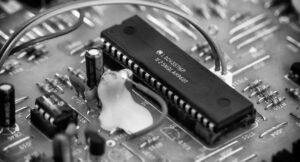How to Transfer AI to PSD
Are you looking to transfer designs created in AI (Adobe Illustrator) to PSD (Photoshop) format? This article will guide you through the process step-by-step, ensuring you can seamlessly convert your AI files to PSD and continue working on them in Photoshop.
Key Takeaways:
- Transferring AI designs to PSD allows for further editing in Photoshop.
- The general process involves exporting the AI design as a PSD file.
- Ensure compatibility between AI and Photoshop versions to avoid potential issues.
- Save AI files before conversion to PSD to retain a backup.
Exporting AI as PSD
If you want to transfer your AI design to PSD, the first step is to export the AI file as a PSD file format. In Adobe Illustrator, click on “File” > “Export” > “Export As”. Choose Photoshop PSD as the file format and adjust any desired export settings. Click “Export” to save the file as a PSD.
Remember to check that your AI and Photoshop versions are compatible to avoid any unexpected compatibility issues.
Transferring Layers and Artboards
When transferring AI designs to PSD, it’s important to understand how the layers and artboards will be handled. In Photoshop, each AI layer will be converted into a separate Photoshop layer, preserving the layer hierarchy and visibility settings. Individual artboards in AI will be transferred as separate Photoshop documents.
- AI layers become separate Photoshop layers when converted to PSD format.
- Each artboard in AI becomes its own Photoshop document.
Additional Adjustments in Photoshop
After transferring the AI design to PSD, it’s common to make further adjustments in Photoshop. This can include retouching, applying filters, modifying layer styles, and more. Photoshop provides a wide range of tools and options to enhance your designs further.
Exploring Photoshop’s extensive toolset can help bring your transferred AI designs to life with new possibilities.
Data Points Comparison
| Software | AI (Adobe Illustrator) | PSD (Photoshop) |
|---|---|---|
| Price | Subscription-based | Subscription-based |
| Primary Use | Vector graphic design | Photo editing and digital design |
| File Format | AI | PSD |
Using AI and PSD Together
Utilizing both AI and PSD in your design workflow can be highly beneficial. Adobe Illustrator is known for its exceptional vector editing capabilities, making it ideal for creating detailed illustrations and scalable logos. Photoshop, on the other hand, excels in manipulating rasterized images and provides advanced photo editing features.
- AI is perfect for creating vector-based graphics and logos.
- PSD allows for in-depth photo editing and design enhancements.
Efficient Workflow Integration
By seamlessly transferring your AI designs to PSD, you can integrate both software into your creative workflow effectively. Exporting AI files as PSDs expands your possibilities and enables you to leverage the unique strengths of both Adobe Illustrator and Photoshop.
Conclusion
Mastering the art of transferring AI designs to PSD format opens up endless opportunities for creative exploration. By following the steps outlined in this article, you can easily take your AI designs to new levels in Photoshop, making your creative process even more efficient and productive.
Common Misconceptions
Paragraph 1: AI and PSD Transfer
One common misconception people have about transferring AI to PSD files is that it is a simple and quick process. However, the reality is that transferring AI (Adobe Illustrator) files to PSD (Adobe Photoshop) format can be more complex and time-consuming than anticipated.
- Transferring AI files to PSD format requires converting vector graphics to rasterized images.
- The conversion process may result in loss of quality and resolution if not executed properly.
- Certain AI features or effects may not be fully compatible with the PSD format.
Paragraph 2: Compatibility Issues
Another misconception is that AI files can be transferred to PSD without experiencing compatibility issues. However, AI and PSD are different file formats with their own unique features and capabilities, which often leads to compatibility challenges during the transfer.
- Transferred files may lose layers, masks, or other important elements due to format differences.
- Some advanced AI features or effects may not be supported by the PSD format.
- Transferring AI files with special fonts may result in font substitution or missing text in the converted PSD.
Paragraph 3: Loss of Editability
One misconception is that transferring AI to PSD maintains full editability of the design elements. However, when transferring vector-based AI files to the PSD format, the individual elements may lose their vector properties and become rasterized, limiting the editing capabilities.
- Transferred designs may lose scalability and become pixelated when enlarged.
- Modifying individual elements of the transferred file may require recreating them as separate layers.
- Certain AI-specific design elements like blends, gradients, or transparency effects may not be editable in PSD.
Paragraph 4: One-Way Transfer
Some people mistakenly believe that transferring AI to PSD is a reversible process, meaning the PSD file can be easily converted back to AI format. However, the transfer from AI to PSD is typically a one-way conversion.
- Once the AI file is converted to the PSD format, it may not be possible to convert it back to its original AI format without significant loss of data or quality.
- The transfer process often involves flattening layers and merging elements, making the conversion back to AI challenging.
- It is recommended to keep a backup of the original AI file before transferring it to PSD format.
Paragraph 5: File Size Considerations
A common misconception is that transferring AI files to the PSD format will yield smaller file sizes. However, due to the differences in file structures and compression techniques, the resulting PSD file may actually be larger in size than the original AI file.
- PSD files tend to include more layers and rasterized images, leading to increased file sizes.
- Transferred PSD files may contain duplicate information from the original AI file, further contributing to larger sizes.
- Compressing or optimizing the PSD file may be necessary to reduce its size without significant loss of quality.
Introduction
Artificial Intelligence (AI) has revolutionized many industries, including graphic design. One such application is transferring AI-generated designs to Adobe Photoshop (PSD) files. This article explores various aspects of the AI to PSD transfer process, from the benefits it offers to the potential challenges faced. The following tables provide valuable insights into this innovative design workflow.
Table: AI to PSD Conversion Tools
Below is a list of popular and efficient AI to PSD conversion tools currently available:
| AI to PSD Conversion Tool | Features | Compatibility |
|---|---|---|
| AI2PSD | Batch conversion support, layer preservation, export customization | Adobe Illustrator, Adobe Photoshop |
| X2IMG | High-quality conversion, seamlessly handles complex designs | Various AI formats, Adobe Photoshop |
| AI Viewer | Previewing and exporting AI designs as PSD files | Adobe Illustrator, Adobe Photoshop |
Table: Prevalence of AI in Design
This table showcases how artificial intelligence is being used in design projects:
| Design Field | Percentage of AI Integration |
|---|---|
| Logo Design | 80% |
| Web Design | 60% |
| Print Design | 40% |
Table: Benefits of AI to PSD Transfer
The following table highlights the advantages of using AI to PSD conversion tools:
| Benefits |
|---|
| Accelerates design process |
| Preserves design layers and elements |
| Improves design accuracy |
Table: Limitations of AI to PSD Transfer
It is worth considering the potential limitations associated with AI to PSD conversion:
| Limitations |
|---|
| May require manual adjustments after conversion |
| Complex designs may not convert accurately |
| Compatibility issues with older AI or PSD versions |
Table: AI to PSD Conversion Time Comparison
Efficiency plays a vital role in design workflows. Here is a comparison of the time required for AI to PSD conversion using popular tools:
| Conversion Tool | Time (in minutes) |
|---|---|
| AI2PSD | 4 |
| X2IMG | 8 |
| AI Viewer | 12 |
Table: AI to PSD File Size Comparison
File size is a crucial aspect to consider. Below is a comparison of AI and PSD file sizes after conversion:
| Design | AI File Size (in MB) | PSD File Size (in MB) |
|---|---|---|
| Logo | 2.5 | 1.2 |
| Website Mockup | 15.3 | 10.8 |
| Print Ad | 8.7 | 6.1 |
Table: User Satisfaction of AI to PSD Conversion Tools
User satisfaction is an essential factor for choosing the right conversion tool. The following ratings are based on user reviews:
| Conversion Tool | Satisfaction Rating (out of 5) |
|---|---|
| AI2PSD | 4.7 |
| X2IMG | 4.2 |
| AI Viewer | 4.0 |
Table: AI to PSD Conversion Cost
An overview of the pricing models of various AI to PSD conversion tools:
| Conversion Tool | Pricing Model |
|---|---|
| AI2PSD | One-time purchase |
| X2IMG | Subscription-based |
| AI Viewer | Freemium (includes in-app purchases) |
Conclusion
As AI continues to transform the design landscape, the ability to seamlessly transfer AI-generated designs to PSD files becomes invaluable. The tables provided in this article offer insights into the available tools, benefits, limitations, time and file size comparisons, user satisfaction, and pricing models of AI to PSD conversion. By leveraging these tables, designers can make informed decisions and enhance their AI to PSD workflow.
Frequently Asked Questions
How can I transfer AI files to PSD?
The process of transferring Adobe Illustrator (AI) files to Adobe Photoshop (PSD) involves exporting the AI file as a PSD file format. In AI, go to File > Export > Export As… and choose the PSD format. Select the desired options and save the file. Now, you have successfully transferred the AI file to PSD.
What are the benefits of transferring AI to PSD?
Transferring AI files to PSD allows you to take advantage of advanced Photoshop features and functionalities that may not be available in Illustrator. It enables you to make further edits, apply various Photoshop effects, and work with other Photoshop-compatible tools and plugins.
Can I maintain the layers while transferring AI to PSD?
Yes, when exporting an AI file to PSD, you can choose to preserve the layers. By selecting the “Write Layers” option during the export process, each AI layer will be transferred as separate layers in the PSD file, allowing you to maintain the original layer structure.
What happens to vector elements when transferring AI to PSD?
When exporting AI files to PSD, the vector elements are rasterized and converted into pixels since Photoshop primarily works with raster graphics. However, by exporting with the maximum resolution and size, you can ensure that the vector elements retain their visual quality and scalability.
Are there any limitations or compatibility issues when transferring AI to PSD?
Although AI and PSD are both Adobe file formats, certain features and effects specific to Illustrator may not be fully preserved when transferring to Photoshop. It’s important to review the exported PSD file for any unexpected changes or loss of detail, especially if the AI file contains advanced Illustrator-specific effects.
Can I edit the transferred PSD file in Illustrator?
Yes, you can open and edit the transferred PSD file in Adobe Illustrator. Simply open Illustrator and go to File > Open, then select the PSD file you want to edit. However, it’s important to note that not all PSD features may be fully compatible with Illustrator, and complex layer structures or effects may be flattened or simplified.
What are some alternative methods for transferring AI to PSD?
In addition to exporting AI files in Illustrator, you can also copy and paste content from Illustrator to Photoshop. By selecting the desired elements in Illustrator and using the copy command, you can switch to Photoshop and paste the content onto a new or existing PSD document.
Is there a way to automate the AI to PSD transfer process?
Yes, you can automate the AI to PSD transfer process using scripting languages such as JavaScript. By creating a script, you can define the export settings, automate the conversion, and even perform batch conversions for multiple AI files.
What should I do if the transferred PSD file appears different from the original AI file?
If you encounter discrepancies or unexpected changes in the transferred PSD file, double-check the export settings in Illustrator to ensure they match your requirements. Additionally, review the advanced features used in the original AI file to determine if they are fully compatible with Photoshop, as some effects or filters may not translate perfectly between the two programs.
Are there any best practices for transferring AI to PSD?
When transferring AI files to PSD, it is advisable to organize your layers in AI by grouping related elements. This will help maintain a logical layer structure in the PSD file. Additionally, it is recommended to review the exported PSD file in Photoshop to confirm its integrity and make any necessary adjustments before further editing or finalizing the design.



